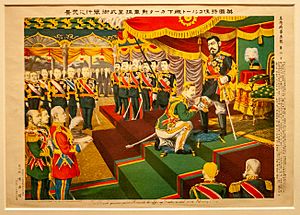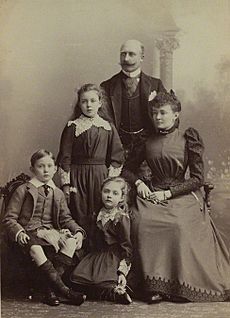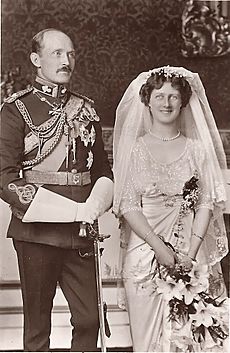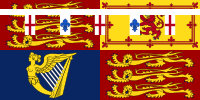Prince Arthur of Connaught facts for kids
Quick facts for kids Prince Arthur |
|||||
|---|---|---|---|---|---|
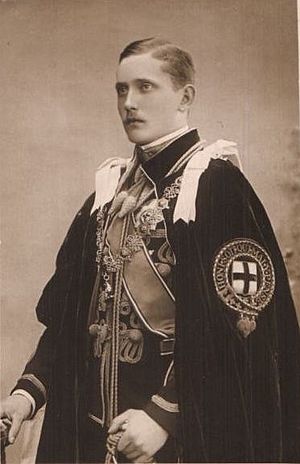
Prince Arthur in the robes of the Order of the Garter
|
|||||
| 3rd Governor-General of South Africa | |||||
| In office 20 November 1920 – 21 January 1924 |
|||||
| Monarch | George V | ||||
| Prime Minister | Jan Christiaan Smuts | ||||
| Preceded by | The Viscount Buxton | ||||
| Succeeded by | The Earl of Athlone | ||||
| Born | 13 January 1883 Windsor Castle, Berkshire |
||||
| Died | 12 September 1938 (aged 55) Belgravia, London, England |
||||
| Burial | 22 September 1938 Royal Vault, St George's Chapel, Windsor Castle 29 February 1939 Royal Burial Ground, Frogmore |
||||
| Spouse | |||||
| Issue | Alastair Windsor, 2nd Duke of Connaught and Strathearn | ||||
|
|||||
| House | Windsor (from 1917) Saxe-Coburg and Gotha (until 1917) |
||||
| Father | Prince Arthur, Duke of Connaught and Strathearn | ||||
| Mother | Princess Louise Margaret of Prussia | ||||
| Military career | |||||
| Allegiance | United Kingdom | ||||
| Service/ |
British Army | ||||
| Years of service | 1901–1922 | ||||
| Rank | Colonel | ||||
| Unit | Royal Scots Greys | ||||
Prince Arthur of Connaught was a British prince, a military officer, and a grandson of Queen Victoria. He was born on January 13, 1883, and passed away on September 12, 1938. He also served as the Governor-General of the Union of South Africa from 1920 to 1924.
Contents
Early Life and Education
Prince Arthur was born at Windsor Castle on January 13, 1883. His father was Prince Arthur, Duke of Connaught and Strathearn, who was the third son of Queen Victoria. His mother was Princess Louise Margaret of Prussia.
Arthur was the first British royal prince to attend Eton College, a famous school. His family called him "young Arthur" to tell him apart from his father, who had the same name.
Military Career and Public Service
Prince Arthur started his military training at the Royal Military College, Sandhurst when he was 16. In May 1901, he joined the 7th (Queen's Own) Hussars as a second lieutenant. He was sent to South Africa in 1902 after the Second Boer War to help keep the peace.
In 1905, he became an aide-de-camp (a personal assistant) to his uncle, King Edward VII. He was promoted to captain in 1907 in the 2nd Dragoons (Royal Scots Greys). Later, in 1920, he became the honorary Colonel-in-Chief of this regiment.
During the First World War, Prince Arthur served as an aide-de-camp to important generals leading the British forces in France and Belgium. He continued to rise in rank, becoming a lieutenant colonel in 1919 and an honorary major general in 1920.
Because the King's own children were too young for public duties, Prince Arthur often represented the royal family at events. For example, he opened the Scottish National Exhibition in Edinburgh.
Marriage and Family
On October 15, 1913, Prince Arthur married Princess Alexandra, 2nd Duchess of Fife. She was his first cousin once removed. Her mother was Louise, Princess Royal, who was the eldest daughter of King Edward VII.
Prince Arthur and Princess Alexandra had one son, named Alastair Windsor, 2nd Duke of Connaught and Strathearn.
Later Life and Royal Duties
After his cousin, King George V, became king, Prince Arthur took on many royal duties. He was one of the most senior male members of the royal family living in the United Kingdom. He often acted as a Counsellor of State when the King was away.
In 1906, Prince Arthur traveled to Japan to present the Order of the Garter to the Meiji Emperor. This was a special honor given because of the friendship between Britain and Japan. He visited Japan again in 1918.
In 1920, Prince Arthur became the Governor-General of the Union of South Africa. This was a very important role, representing the King in South Africa. He served in this position until 1924.
After returning to Britain, Prince Arthur became involved in many charities. He was the chairman of the board of directors for Middlesex Hospital. He was also active in the Freemasons, a fraternal organization.
One of his last public appearances was at the coronation of King George VI in May 1937.
Prince Arthur of Connaught passed away on September 12, 1938, at the age of 55. He was buried at the Royal Burial Ground, Frogmore. His father, the Duke of Connaught, lived for four more years after him. Prince Arthur's son later became the 2nd Duke of Connaught and Strathearn, but he passed away the following year.
Honours and Titles
Prince Arthur received many honors and military ranks throughout his life.
Military Ranks
- Second Lieutenant: 1901
- Lieutenant: 1903
- Captain: 1907
- Brevet Major: 1913
- Major: 1915
- Brevet Lieutenant-Colonel: 1919
- Honorary Major-General: 1920
- Colonel, Reserve of Officers: 1922
Orders and Appointments
- Royal Knight of the Garter (KG): 1902
- Knight of the Thistle (KT): 1913
- Privy Counsellor (PC): 1910
- Companion of the Order of the Bath (CB): 1915
- Royal Victorian Chain: 1906 (for his trip to Japan)
- Knight Grand Cross of the Most Distinguished Order of St Michael and St George (GCMG): 1918
- Knight Grand Cross of the Royal Victorian Order (GCVO): 1899
- Personal aide-de-camp to the King (ADC): 1905
- Bailiff Grand Cross of St John (GCStJ): 1926
Medals
- 1914 Star: 1917
- British War Medal: 1919
- Victory Medal: 1919
- Queen Victoria Diamond Jubilee Medal: 1897
- King Edward VII Coronation Medal: 1902
- King George V Coronation Medal: 1910
- King George V Silver Jubilee Medal: 1935
- King George VI Coronation Medal: 1937
Honorary Military Appointments
- Colonel-in-Chief of The Royal Scots Greys (2nd Dragoons): 1921
- Colonel-in-Chief of the Royal Army Pay Corps: 1937
Arms
As a grandson of a British monarch, Prince Arthur had a special coat of arms. It featured the royal arms with some changes to show his place in the family. Before 1917, his arms also included a small shield representing the House of Saxony, where his family came from. This was removed in 1917.
|
|
|
|
|
See also
 In Spanish: Arturo de Connaught para niños
In Spanish: Arturo de Connaught para niños


